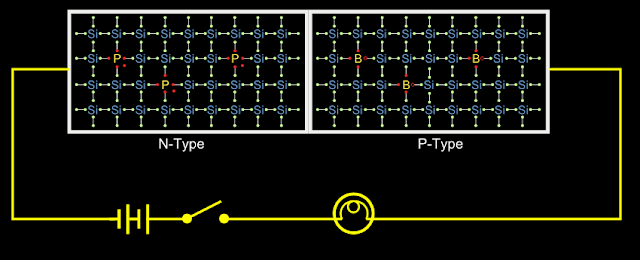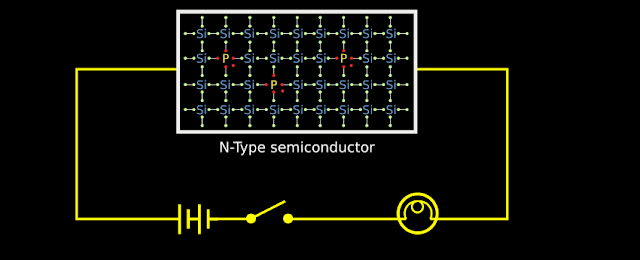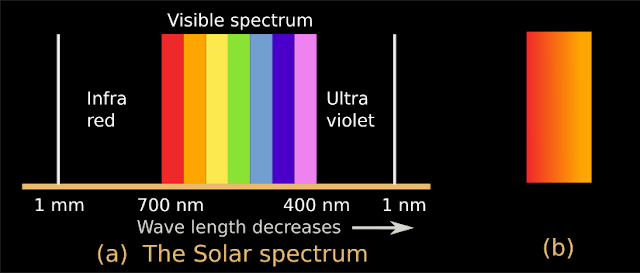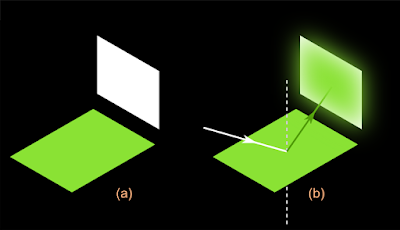In the previous section we saw semiconductors. In this section we will see some basic electronic components.
We have seen p-type and n-type semiconductors. Consider the silicon crystal shown in fig.14.7 below:
We will write an analysis in steps:
1. Left side of the crystal is doped with phosphorus
♦ So the left side becomes a N-type semiconductor
2. Right side of the crystal is doped with boron
♦ So the right side becomes a P-type semiconductor
■ There is a clear boundary between the two regions
3. Let us connect this new device in a circuit. It is shown in fig.14.8 below:
In the fig.14.8:
(i) n-region is connected to the positive terminal of the cell
♦ So the free electrons in the n-region are attracted towards the positive terminal
(ii) p-region is connected to the negative terminal of the cell
♦ The holes in the p-region are attracted towards the negative terminal
(iii) So the result:
♦ The electrons in the left are moving towards the left
♦ The holes in the right are moving towards the right
(iv) So the electrons and holes are moving away from each other. They are not moving towards each other.
■ Thus no electron will cross the boundary between the two regions. So current will not flow. The bulb will not glow.
4. Let us flip the terminals of the cell. It is shown in fig.14.9 below:
In the fig.14.9:
(i) n-region is connected to the negative terminal of the cell
♦ So the free electrons in the n-region are repelled towards the boundary
(ii) p-region is connected to the positive terminal of the cell
♦ The holes in the p-region are repelled towards the boundary
(iii) So the result:
♦ The electrons in the left are moving towards the right
♦ The holes in the right are moving towards the left
(iv) So the electrons and holes are moving towards each other. They are not moving away from each other.
■ Thus electrons will cross the boundary between the two regions. So current will complete the circuit. The bulb will glow.
The semiconductor device that we just saw above is called a diode. We can write:
■ Diode is an electronic component obtained by suitable doping of a semiconductor in such a way that one region is p-type and other region is n-type
• It's symbol is shown in fig.14.10(a) below.
♦ We can see an arrow pointing towards the left.
♦ The base of this arrow is the p-region of the diode. So it is + ve
♦ The tip of this arrow is the n-region of the diode. So it is - ve
• Using this symbol:
♦ We can simplify fig.14.8 that we saw above into the smaller fig.14.10(b) below.
♦ We can simplify fig.14.9 that we saw above into the smaller fig.14.10(c) below:
• When the switch in fig.14.10(b) above is turned on, the bulb will not glow
• When the switch in fig.14.10(c) above is turned on, the bulb will glow
■ Current flows through a diode when the connection is made in this way:
• The p-region of that diode is connected to the positive terminal of the cell
• The n-region of that diode is connected to the negative terminal of the cell
• Connecting a diode in this manner is forward biasing
■ Current does not flow through a diode when the connection is made in this way:
• The p-region of that diode is connected to the negative terminal of the cell
• The n-region of that diode is connected to the positive terminal of the cell
• Connecting a diode in this manner is reverse biasing.
We have seen p-type and n-type semiconductors. Consider the silicon crystal shown in fig.14.7 below:
 |
| Fig.14.7 |
1. Left side of the crystal is doped with phosphorus
♦ So the left side becomes a N-type semiconductor
2. Right side of the crystal is doped with boron
♦ So the right side becomes a P-type semiconductor
■ There is a clear boundary between the two regions
3. Let us connect this new device in a circuit. It is shown in fig.14.8 below:
 |
| Fig.14.8 |
(i) n-region is connected to the positive terminal of the cell
♦ So the free electrons in the n-region are attracted towards the positive terminal
(ii) p-region is connected to the negative terminal of the cell
♦ The holes in the p-region are attracted towards the negative terminal
(iii) So the result:
♦ The electrons in the left are moving towards the left
♦ The holes in the right are moving towards the right
(iv) So the electrons and holes are moving away from each other. They are not moving towards each other.
■ Thus no electron will cross the boundary between the two regions. So current will not flow. The bulb will not glow.
4. Let us flip the terminals of the cell. It is shown in fig.14.9 below:
 |
| Fig.14.9 |
(i) n-region is connected to the negative terminal of the cell
♦ So the free electrons in the n-region are repelled towards the boundary
(ii) p-region is connected to the positive terminal of the cell
♦ The holes in the p-region are repelled towards the boundary
(iii) So the result:
♦ The electrons in the left are moving towards the right
♦ The holes in the right are moving towards the left
(iv) So the electrons and holes are moving towards each other. They are not moving away from each other.
■ Thus electrons will cross the boundary between the two regions. So current will complete the circuit. The bulb will glow.
The semiconductor device that we just saw above is called a diode. We can write:
■ Diode is an electronic component obtained by suitable doping of a semiconductor in such a way that one region is p-type and other region is n-type
• It's symbol is shown in fig.14.10(a) below.
♦ We can see an arrow pointing towards the left.
♦ The base of this arrow is the p-region of the diode. So it is + ve
♦ The tip of this arrow is the n-region of the diode. So it is - ve
• Using this symbol:
♦ We can simplify fig.14.8 that we saw above into the smaller fig.14.10(b) below.
♦ We can simplify fig.14.9 that we saw above into the smaller fig.14.10(c) below:
 |
| Fig.14.10 |
• When the switch in fig.14.10(c) above is turned on, the bulb will glow
■ Current flows through a diode when the connection is made in this way:
• The p-region of that diode is connected to the positive terminal of the cell
• The n-region of that diode is connected to the negative terminal of the cell
• Connecting a diode in this manner is forward biasing
■ Current does not flow through a diode when the connection is made in this way:
• The p-region of that diode is connected to the negative terminal of the cell
• The n-region of that diode is connected to the positive terminal of the cell
• Connecting a diode in this manner is reverse biasing.





















